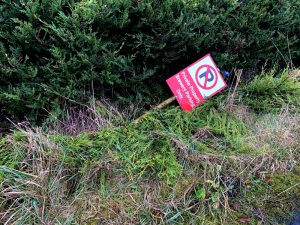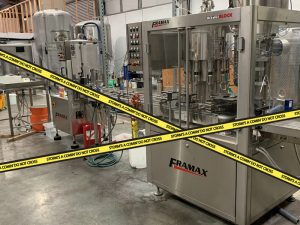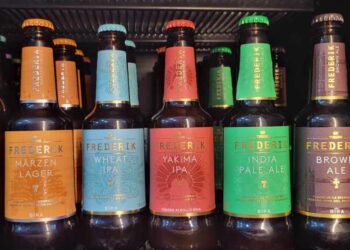“Is it beer o’clock yet” is often heard, but what about “Is it Beer Weather”? We’ve made our morning commute thousands of times. On roads with which we are all too familiar. This dark and wet morning though, the amount of debris, branches and water strewn across our well worn route lent it a sense of the unfamiliar; an adventure. With storm Barra swinging by to pay us a visit sometime today, for the first time in our 7-year history we have had to make a production decision based on the weather forecast.
Blown Away

No Parking.
We were scheduled to bottle a batch of Buck It our Amber Beer this morning, but with the very realistic prospect of the weather causing power cuts sometime during the day, we’ve had to postpone the bottling until later this week. We made the decision to postpone because although we employ a very old and traditional bottling technique, our modern, semi automated bottling line is wholly dependant on an uninterrupted flow of electricity.
Natural Beer, Naturally
True 100% bottle conditioning, means the beer is flat when it is bottled, it then undergoes a secondary fermentation process in the sealed bottle, trapping the carbon dioxide produced by the yeast during the secondary fermentation, and thereby carbonating itself. It is a very traditional and complex technique, not very widely used in modern breweries largely because it’s complex, and relatively inefficient. The benefits to this technique however are many, including a finer, smoother carbonation texture, better foam stability, more complex flavour development, longer shelf life, and the potential for better ageing.
We never add industrial CO2 to our bottled beer. All of our bottles are naturally carbonated using only the CO2 produced during the fermentation process. Much of the CO2 used in the brewing industry is a by-product of heavy chemical manufacturing, particularly from fertiliser plants. Since we produce our own CO2, we are thankfully immune to the spiralling costs and tightening supply of industrial CO2. On the other hand, production times are longer as the refermentation process generally takes about 14 days to complete.
The Yeast Set The Schedule

No work today, there’s a storm coming!
We prime the beer in the bulk tank with some conditioning sugar or unfermented beer (wort), and some fresh yeast, prior to bottling. It is imperative to package the beer as soon as possible once it is primed. If the yeast wake up in the bulk tank and begin to referment the beer we can no longer bottle it. We can sometimes switch to filling kegs, but not with this particular brand. Alternatively, the beer has to go down the drain, and that simply doesn’t make for a good day at work!
Fools Rush In, Whatever the Weather
Erring on the side of caution, we decided to do a little shuffling, and push the bottling run out until later this week. At least this unscheduled interruption has given me a chance to pen this blog post. As I sign off though, it is about the time we would be finishing up the bottling run, and the lights haven’t so much as flickered. Looks like it’s beer o’clock.





